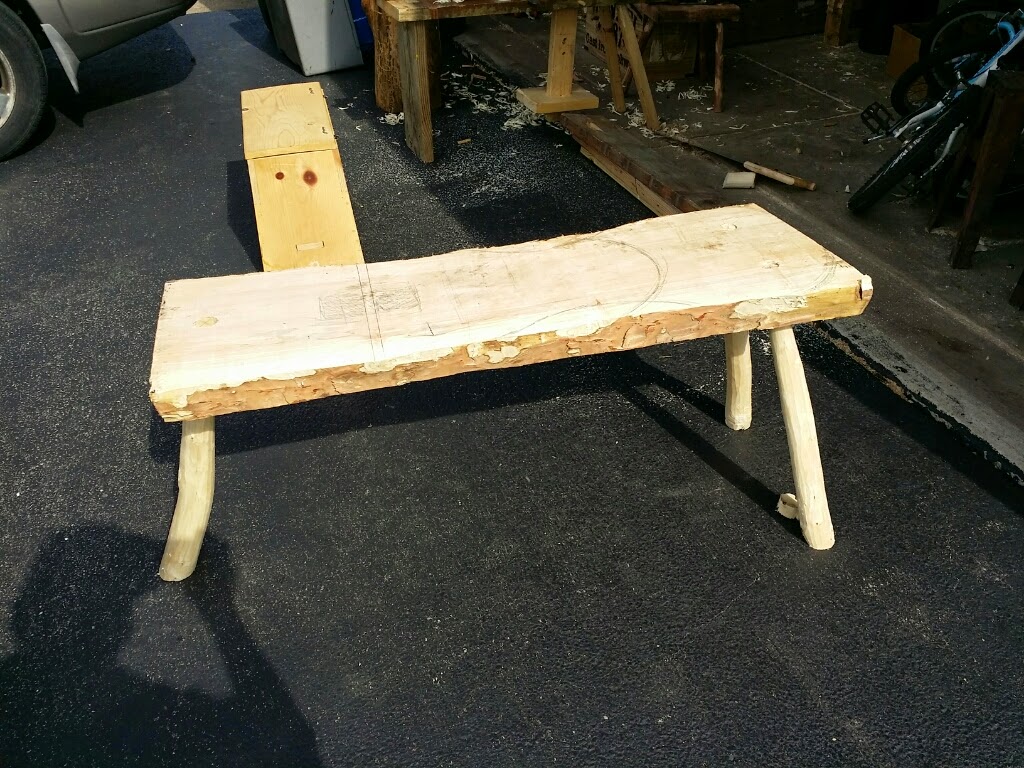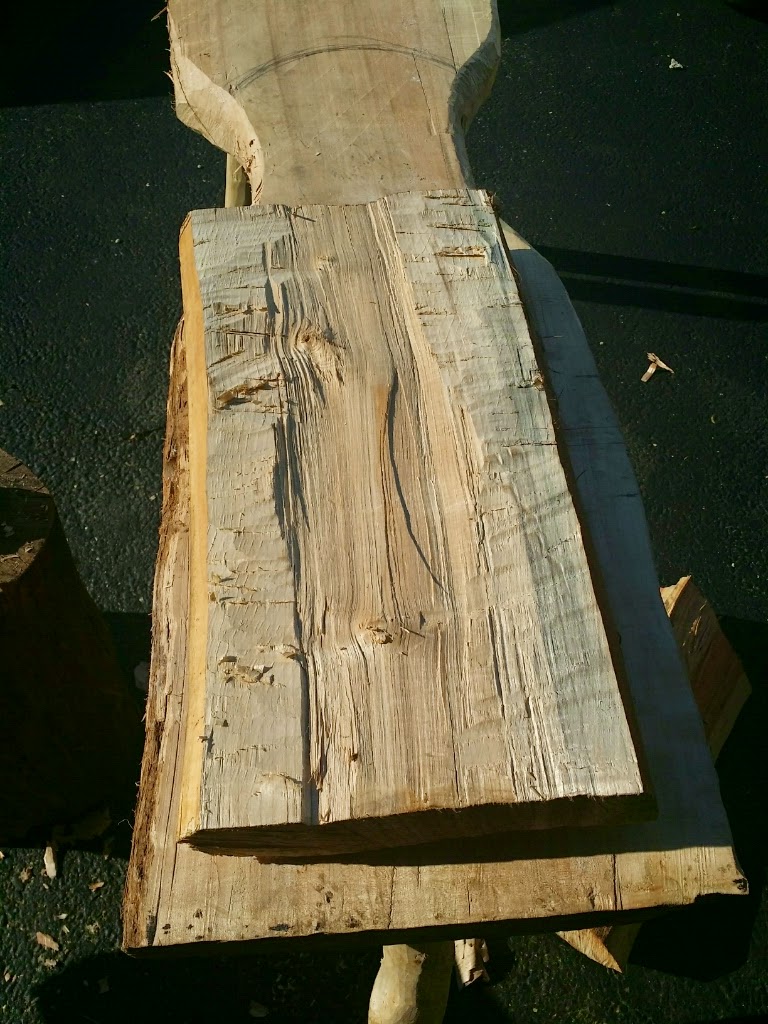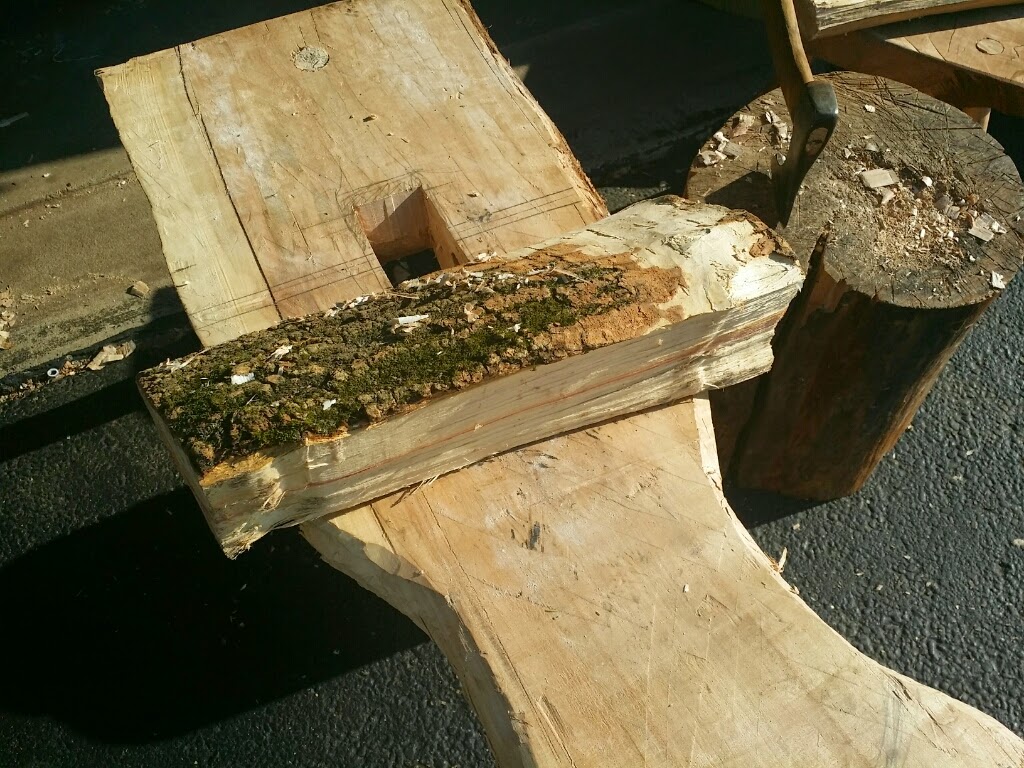I must say that I've been having a tone of fun making my shavehorse and pole lathe. There is great joy making something from tree to finished product. Even though my finished product will look very rustic I highly recommend taking a piece of green wood and making it into something. Very rewarding.
The shavehorse progresses and now needs legs. I found a few decent sized green branches from a local neighbor who had a tree removal. The tree was a maple tree so the finished look should match the bench top of the shavehorse. The pieces I chose for the legs are not exactly straight, but I like the character. I used my completed "modern" shave horse to remove the bark and draw the legs down to a slow taper. I then sketched a circle at the end the size of the auger bit I had.
How thick should the legs be? Well, that's easy. How big is the biggest auger bit you have?
Remnants of an afternoon of fun. I filled two lawn bags with shavings from the shavehorse legs and some other projects I was working on at the same time. As long as I had the bench out why not put it to use and clean up only one time?
I probably should have measure better and gauged the angle of the auger when drilling the leg holes, but alas, I did not. Always the eager beaver I simply eyeballed it and went to town with the auger. Drilling holes in green maple is SO much easier than drilling through the oak I used for my bench. Using an auger in green wood is almost more fun than work.
Legs mounted and loosely fit. I placed the two straightest legs in the back and the the leg with the largest bend in the front. Not sure if the placement matters as they are all VERY sturdy but I like the look better that way. I need to make this bench portable so I don't intend to wedge the legs in.
To ensure that the base of each leg is cut parallel with the bench I did some make shift engineering. I placed a small box and a board on the bottom of the bench as you see below. The bench and board together matched about the height that I wanted the legs to be. I could then rest my saw on the board and proceed to cut the legs. This ensured that the angle of the base of each leg would sit flush with the ground. With only three legs, once cut this bench became the sturdiest piece of furniture I've ever made.
Once the legs were place I then sat on the bench to check the fit. I sat and leaned back in the position I would be when using the bench and sketched some lines where I would remove some material. I don't want to remove any more material than I need to as I want the bench to be as beefy as possible.

I marked the lines where material would be removed and then used the auger again to make some holes. I then used a hand saw to cut into the holes.
Once cut I simply had to use a chisel to cut along the grain. At this point I sat on the bench again and found that the small incuts I did made the bench more comfortable for use. Once the head is in place I may round it up and take off a bit more material but for now I like the fit.
I learned a bit from the last bench I made. This time around I planned to drill the hole through the width of the bench and THEN cut out the section in the middle. This would ensure that the holes on each side of the bench would align perfectly.
I used a pencil to mark the line I wanted to drill along. I purchased a new auger bit to fit in my hurdy gurdy hand drill. To aid in the drilling I took my measuring stick and taped it parallel to the hole. I could then eyeball the drill and keep it parallel to the stick.
Drilling green wood is much easier than dry wood but using this drill was still tough. Once I got about half way through the drilling progress was very tiring.
Once drilled I compared the actual line with the expected line. I drifted off the line a small amount but I don't think it will be an issue.

Again time to eyeball the design. I took a couple pieces of wood I had lying around to get a look at the design. I sat on the bench and then outlined my foot print to see the position I would be in during use. That would help me guage the angle for the head of the shavehorse. Next step is to make the shaft that the head will mount to.
Another chunk of maple found in the neighborhood. Originally I had wanted to get a piece large enough so that the head and the shaft would be cut from a single piece. I have not yet found a log large enough so I had to make the shaft from one piece and a head from another. I may replace this section in the future.
I cut the log almost in half. As I have no real plans I have been simply eyeballing the pieces as I go along. I think that perhaps the slightly curved section might be interesting to use to increase the leverage of the fulcrum. To begin with, however, I chose to use the slightly longer piece on the bottom below.
The log was rather straight along one axis and less straight on the other.


I needed to flatten the shaft without taking too much material. I like the round "rustic" look but wanted a flat piece that would slide in and out of the shavehorse for easy assembly.
I took some painters tape and stretched it tight. I know I could have used a chalk line but I like this approach. Pulling the tape tight forces it to make a straight line. I could then eyeball the blue section to see if that fit my vision. Once satisfied all I had to do was remove the material without tape with a hewing axe.
Roughly straight now. I removed the tape and then cleaned up the piece with a small hand plane.
I drilled some holes in the bench and then used chiselse to square up the hole. The hole was cut to the size of the shaft.
So far so good. Before I drill the shaft and mount it to the bench I need to build the head and make sure it fits. Once satisfied with the mounting of the head I will mark the place for the shaft to be drilled for the fulcrum.
I cut a mortise through the head using some chisels and then roughed out the shape with only an axe. I love cutting green wood with and axe. Other than the hole in the middle this entire piece was roughed out with a single axe. I will come back and clean it up later with some planes but for now it will allow me to proceed.

The shavehorse is basically a foot operated vise. The top of the vise, or the head, is movable. The bottom of the vise is static. Based on experience with my current more modern looking shavehorse I decided that I wanted to make the bottom of the vise adjustable. It would be made of a plank and a foot beneath the plank. By adjusting the thickness of the foot I could increase the height of the plank and thus adjust the opening of the vise.
I roughed out the plank above using a piece of maple I had on hand. This was actually split from an old arming stump I have had for about 8 years. It was severely checked and damaged so I decided to retire it and make it into boards. Cutting dried maple is A LOT tougher than the green maple the rest of the bench is made from.
The piece you see below is a piece of american ash. It has a lovely red streak through it. The tree was at a friend's house and was almost dead when we cut it down. I salvaged some of the wood for use but found that it is really very light and in some cases just too spongy to use. Some pieces like the one below was solid enough to use. As the foot of the vise won't take a lot of pressure I don't mind that it isn't as tough as maple. I really wanted to work some of the red stained wood into a project.
I plan on cutting the foot at two different angles. I will be able to simply rotate the foot to allow for and adjustment of the height. I used my measuring stick to predict the angle I wanted and then sketched a line on the ash. I used a hewing axe to cut along my line. The finished foot allows for two different angles about an inch different. This will allow me to easily adjust the opening of the vise. I have found that quick and easy adjustment of the opening to be very useful when working with green wood. I can very quickly take an inch or two off the diameter of a piece of wood while working it. It will help to be able to close the vise opening to fit a slightly smaller piece and continue working it.


































